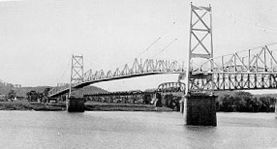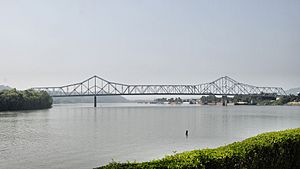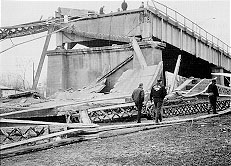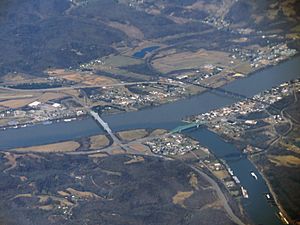Silver Bridge facts for kids
Quick facts for kids Silver Bridge |
|
|---|---|

The Silver Bridge upon completion in 1928
|
|
| Coordinates | 38°50′42″N 82°08′28″W / 38.84500°N 82.14111°W |
| Crosses | Ohio River |
| Locale | Point Pleasant, Mason County, West Virginia, United States Kanauga, Gallia County, Ohio, United States |
| Followed by | Silver Memorial Bridge |
| Characteristics | |
| Design | suspension bridge |
| Material | Steel |
| Total length | 2,235 feet (681 m) |
| Longest span | 700 feet (210 m) |
| Piers in water | 2 |
| Design life | 39 years (until collapse) |
| History | |
| Designer | J. E. Greiner Company |
| Constructed by | American Bridge Company |
| Opened | May 30, 1928 |
| Collapsed | December 15, 1967 |
The Silver Bridge was a special type of suspension bridge built in 1928. It got its name from its shiny aluminum paint. This bridge helped people cross the Ohio River, connecting Point Pleasant, West Virginia, and Gallipolis, Ohio.
On December 15, 1967, the Silver Bridge suddenly collapsed. This happened during busy rush-hour traffic. Sadly, 46 people lost their lives, and two of them were never found. Investigators later found that a small flaw in one part of the bridge, called an eyebar, caused the collapse. The bridge was also carrying much heavier loads than it was built for. It had not been kept up very well over the years. A new bridge, the Silver Memorial Bridge, was built to replace it in 1969.
Contents
Understanding the Silver Bridge
How the Bridge Was Built
The Silver Bridge was a suspension bridge that used strong steel parts called eyebars. These eyebars were linked together like a chain to hold up the bridge deck. Unlike many older bridges that used many eyebars for safety, the Silver Bridge used only two eyebars for each link. These two bars were made of very strong steel.
This design meant that if one of the two bars failed, the other one would have to carry too much weight. This could cause the whole link, and then the whole bridge, to break. Older bridges often had many more bars. If one of those broke, the others could still hold the bridge up. This extra safety is called "redundancy." The Silver Bridge had very little redundancy.
Special Towers
The towers of the Silver Bridge were "rocker" towers. This meant they could tip slightly to help the bridge move with traffic and wind. However, these towers needed the suspension chains on both sides to stay standing. If any part of a chain broke, the entire bridge would fall.
Heavier Traffic Over Time
When the Silver Bridge was built in 1928, cars like the Ford Model T were common. They weighed about 1,500 pounds (680 kg). The heaviest trucks allowed weighed about 20,000 pounds (9 tonnes).
By 1967, when the bridge collapsed, cars were much heavier, around 4,000 pounds (1,800 kg). Large trucks could weigh 60,000 pounds (27 t) or more. Also, the bridge often had bumper-to-bumper traffic jams. This meant the bridge was under much more stress than it was designed for.
What Happened After the Collapse?
The collapse of the Silver Bridge made people realize that many older bridges needed to be checked. This led to new rules for inspecting bridges. Many old bridges were replaced with newer, safer designs.
Only two other bridges were built with a similar design to the Silver Bridge.
- One was upstream in St. Marys, West Virginia. It was closed right away and taken down in 1971. A new bridge, the Hi Carpenter Memorial Bridge, was built there later.
- The other similar bridge is the Hercilio Luz Bridge in Florianópolis, Brazil. It was built with stronger safety features. It was used until 1991 and reopened in 2019 after being fixed up.
The Silver Bridge disaster led to new laws. These laws made sure that old bridges were regularly checked and fixed. Even with these rules, old bridges still need attention in the United States. Other bridge collapses have happened since, like the Mianus River Bridge in 1983 and the I-35W Mississippi River bridge in 2007.
Remembering the Bridge
A small model of the original Silver Bridge was once shown at the Point Pleasant River Museum. The museum also had information about the bridge. An actual eyebar from the bridge was on display there. The museum closed in 2018 due to fire damage, so the future of these exhibits is unknown.
Another eyebar from the bridge can be seen at a rest area on the Ohio side of the river, along Route 7. A memorial was also placed in Point Pleasant to remember the 46 people who died in the collapse.
Lessons Learned
The collapse of the Silver Bridge taught engineers an important lesson. It showed that even small design choices can have big consequences. The investigation found that the bridge's design made it almost impossible to check for hidden problems. This meant failure was very likely.
Engineers today are reminded to always be very careful. They must think about all possible problems, even the ones they don't know about yet. The Silver Bridge's legacy is a reminder to always design with the greatest care and safety in mind.
Silver Memorial Bridge
| Silver Memorial Bridge | |
|---|---|
 |
|
| Coordinates | 38°50′04″N 82°08′51″W / 38.83444°N 82.14750°W |
| Carries | 4 lanes of |
| Crosses | Ohio River |
| Locale | Gallipolis, Ohio to Henderson, West Virginia |
| Characteristics | |
| Design | cantilever bridge |
| Total length | 1,964 feet (599 m) |
| Width | 60 feet (18 m) |
| Longest span | 900 feet (270 m) |
| Clearance below | 69 feet (21 m) |
| History | |
| Opened | December 15, 1969 |
The Silver Memorial Bridge is a cantilever bridge that crosses the Ohio River. It connects Gallipolis, Ohio, and Henderson, West Virginia. This bridge was finished in 1969. It was built to replace the collapsed Silver Bridge. It is located about 1 mile (1.6 km) downstream from where the original bridge stood.
The bridge carries US 35 across the river. It is an important crossing for people and goods traveling between Charleston, West Virginia, and Southern and Central Ohio. The speed limit on the bridge is 55 mph (105 km/h). There is no toll to cross it.
See also
 In Spanish: Silver Bridge para niños
In Spanish: Silver Bridge para niños



